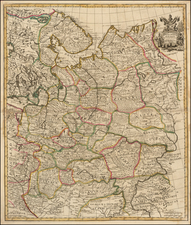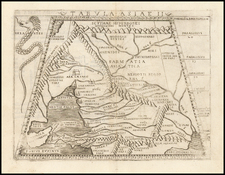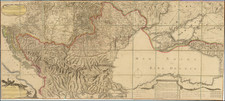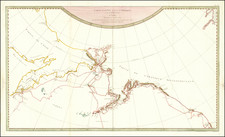Rare separately published map of Russia and environs based upon a Russian published map by Theodor Friedrich Schubert, first issued in 1829.
The map title translates as follows:
War Roads Map of a Part of Russia and the Adjacent Countries. Based on the map published in 1829 under the supervision of the Russian Imperial General Staff by General Major Schubert at a scale of 1/1680000, enlarged to the scale of 1/1400000 by the k.k. [Imperial and Royal] Austro-Hungarian General Headquarters Staff Issued in the Year 1837.
The map is a rare and important military map covering nearly the whole of European Russia and parts of neighboring countries, by the distinguished Russian military cartographer Theodor Friedrich Schubert (Russian: Fedor Fedorovich Shubert). Schubert's map was first published in 8 sheets at a scale of 1:1,168,000 in 1829. The present enlarged example is at a much-improved scale compared to the original Russian map, offering a detailed depiction of topography, roads, waterways, military colonies, and old fortifications.
The map covers large parts of Finland in the north (up to about the height of Arkhangelsk), stretches in the west to the line of Stockholm-Krakow, shows the northern and eastern shores of the Black Sea to Tbilisi and Yerevan in the south, and approximately follows the line of Astrakhan-Nizhny Novgorod-Vyatka in the east. Thus, the map includes not only the Scandinavian countries but also large parts of Poland, East Prussia, practically all of Ukraine, Romania, European Russia, the far eastern part of Turkey near Trabzon, Georgia, Armenia, and Kazakhstan.
The following is a list of the map symbols and their German names, alongside their Russian and English equivalents.
- HAUPTSTADT (Stoliza, Stolicznyj Gorod) - Capital City
- GOUVERNEMENTSSTADT (Gubernskij Gorod) - Provincial City
- KREISSTADT (Ujezdnyj Gorod) - District City
- STADT (Gorod) - City
- Kleine Stadt oder Flecken (Mjasteczko) - Small Town or Market Town
- Kirchdorf (Selo) - Parish Village
- Kirchspiel (Priegorstpol) Pastorate in den Gouvern. von Kurland, Livland u. Esthland; dann in Schweden. - Parish (specific to the provinces of Courland, Livonia, and Estonia; then in Sweden)
- Dorf (Dierewnja) - Village
- Kloster (Monastyr) - Monastery
- Kirche (Cerkov) - Church
- Hof (Dwor) - Manor
- Wirthshaus (Gastinnica) - Inn
- Kleine Festung/Fort (Krepostec) - Small Fortress/Fort
- Redoute (Redut, Forpost) - Redoubt (Small Fortified Outpost)
- Alte Verschanzung (Drewnie Wały) - Old Entrenchment
- Poststation (Poestovaja stancija) - Post Station
- Leuchtthurm (LT.) (Majak) - Lighthouse (LT.)
- Militär-Colonie (Wojesennija poselenija) - Military Colony
- Sandbanker (Kanal) (Pesoczowyj Bank) - Sandbank (Channel)
- Regulirungsbaken (Beton) (Regulirungsbakj) - Regulatory Beacons (Concrete)
- Chaussée-grosse Poststrasse (Rossi i Bolshaja poestovaja doroga) - Causeway-Main Post Road
- Landstr. kleine Poststrasse (Bolshaja doroga i Malaja poestovaja) - Country Road. Small Post Road
- Landweg (Proseoloknaja ié Malaja doroga) - Country Path (Track and Small Road)
- Winterpoststrasse (Zimnaja poestovaja Doroga) - Winter Post Road
- Kleine Winterstrasse (Zimnaja malaja doroga) - Small Winter Road
- Sommerpoststrasse im Walde (Ljétniaja poestov. dor. w lesu) - Summer Post Road in the Forest
- Staaten = (Gosudarstwennaja) - States
- General-Staatsstrasse (General Gubernatorskaja) - General State Road
- Gouvernements = (Gubernskaja) - Governmental
- Kreise = (Ujezdnaja) - Districts
Theodor Friedrich von Schubert was born in Saint Petersburg, the son of astronomer Theodor von Schubert.
At sixteen, he joined his father on a Russian expedition to China.
He rose to prominence in the Russian army, becoming an infantry general and head of the military topographic service. He fought in the War of the Fourth Coalition (1806), the Finnish War (1808), and the Russo-Turkish War (1810). By 1812, he was an upper quartermaster general and was promoted to colonel after the battle of Leipzig in 1813. From 1815 to 1818, he served with the Russian forces in France, returning thereafter to a general staff position in Russia.
His interest in cartography was notable throughout his career. In 1845, he attained the rank of infantry general.
He died in Stuttgart in 1865, having spent his later years traveling.












![[ Scandinavia ] Tabula Geographica Regnorum Sueciae Daniae et Norwegiae](https://storage.googleapis.com/raremaps/img/small/102797.jpg)
![[Kremlin / Moscow] КРЕМЛЕНА ГРАД. Kremlenagrad, Castellum urbis Moskvae . . .](https://storage.googleapis.com/raremaps/img/small/47466.jpg)


